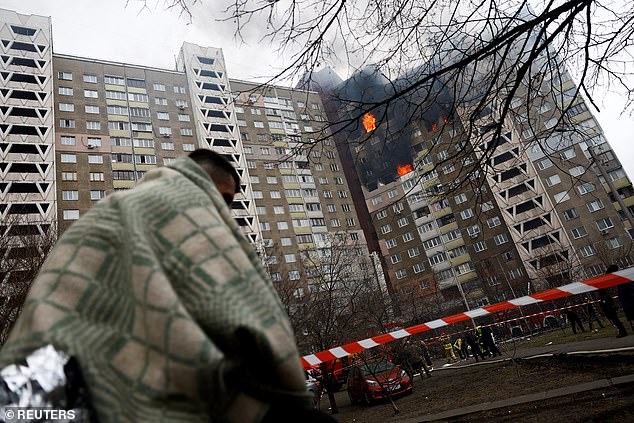
Poland found itself on high alert as Russia launched missiles toward its NATO border with Ukraine, prompting the scrambling of at least three F-16s to assess the potential threat. The missiles, however, changed course and struck targets within Ukraine, escalating the ongoing conflict. The attack raised concerns about the possibility of a wider war involving NATO, a military alliance that includes the United States and the United Kingdom. An assault on a NATO country could trigger Article 5 of the alliance’s treaty, which considers an attack on one member as an act of aggression against all.
The missile strikes conducted by Russia resulted in devastating consequences for Ukraine. Deeply distressing footage from Kyiv depicted residential blocks ablaze, with buildings across the city being targeted. Among the reported targets was a Ukrainian marine drone plant in Mykolaiv, pointing to Russia’s attempt to disrupt Ukraine’s military capabilities. The barrage of attacks was not limited to Kyiv; other major cities like Kharkiv also faced multiple explosions, causing panic and chaos among residents.
The significance of the situation was underscored by Poland’s swift response, activating its air defenses and putting F-16s into action. The use of military aircraft in response to the perceived threat from Russian missiles highlighted the escalating tensions in the region and the potential for a broader conflict to unfold.
The situation further intensified as Russia continued its assault on various Ukrainian cities, with missile strikes hitting targets in Lviv, Ternopil, Ivano-Frankivsk, and other regions. The onslaught represented one of the worst episodes in the ongoing war, causing extensive damage and casualties. The impact of the attacks extended beyond immediate destruction, affecting infrastructure, displacing civilians, and plunging entire areas into chaos.
The missile strikes on Ukraine occurred against the backdrop of President Volodymyr Zelensky’s recent order to create a separate branch of Ukraine’s armed forces devoted to drone capabilities. Drones have become a critical component in Ukraine’s defense strategy, offering effective countermeasures against Russian attacks and aiding in counteroffensives. Zelensky’s emphasis on the importance of drone technology highlighted Ukraine’s commitment to leveraging innovative military strategies to confront the ongoing threat from Russia.
The conflict took a grim turn as residential areas were targeted, resulting in civilian casualties and extensive damage to infrastructure. The use of missiles raised concerns about the indiscriminate nature of the attacks, as residential blocks and civilian spaces became battlegrounds. The toll on human lives and the broader implications for regional stability underscored the urgency of addressing the conflict and finding a diplomatic resolution.
As the missile strikes unfolded, the international community closely monitored the situation, with the potential for NATO involvement looming large. The conflict between Russia and Ukraine has far-reaching consequences, affecting geopolitical dynamics, regional stability, and the lives of those caught in the crossfire. The missile attacks marked a significant escalation, emphasizing the urgent need for diplomatic efforts to quell the violence and pave the way for a sustainable peace in the region.
RELATED ARTICLES
- After Fooling the People to Reelect Putin, Russia now announces More Cannon Fodder Mobilizations
- Russia Fires Barrage of North Korean Missiles at Kyiv After US Visit
- Ex-Wagner fighters Join Free Russia Army's Battle to Liberate Russia from Putin Occupation
- Hungary Becomes First EU Country to Congratulate Putin for Winning the 'Elections'
- Putin says NATO Troops are already in Ukraine But Russia is Still Winning











